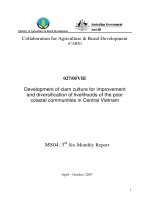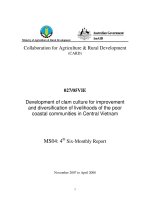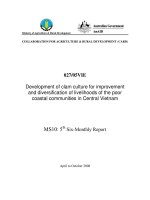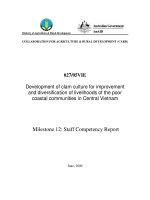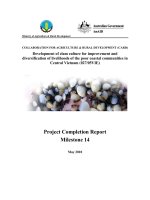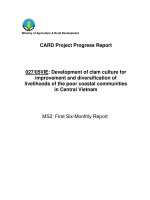Improving the poor material management in construction projects using value stream mapping
Bạn đang xem bản rút gọn của tài liệu. Xem và tải ngay bản đầy đủ của tài liệu tại đây (1.7 MB, 115 trang )
VIETNAM NATIONAL UNIVERSITY HO CHI MINH CITY
HO CHI MINH CITY UNIVERSITY OF TECHNOLOGY
TRAN HOANG ANH
IMPROVING THE POOR MATERIAL MANAGEMENT IN
CONSTRUCTION PROJECTS USING VALUE STREAM
MAPPING
Major: CONSTRUCTION MANAGEMENT
Major Code: 8580302
MASTER’S THESIS
HO CHI MINH CITY, July 2023
THIS THESIS IS COMPLETED AT
HO CHI MINH CITY UNIVERSITY OF TECHNOLOGY – VNU-HCM
Supervisor 1: Dr. Bui Phuong Trinh
Supervisor 2: Assoc. Prof. Dr. Do Tien Sy
Examiner 1: Assoc. Prof. Dr. Tran Duc Hoc
Examiner 2: Dr. Nguyen Hoai Nghia
This master’s thesis is defended at HCM City University of Technology,
VNU-HCM on July 10th, 2023.
Master’s Thesis Committee:
1. Assoc. Prof. Dr. Luong Duc Long
- Chairman
2. Assoc. Prof. Dr. Pham Vu Hong Son
- Secretary
3. Assoc. Prof. Dr. Tran Duc Hoc
- Reviewer 1
4. Dr. Nguyen Hoai Nghia
- Reviewer 2
5. Dr. Pham Hai Chien
- Member
Approval of the Chairman of Master’s Thesis Committee and Dean of
Faculty of Civil Engineering after the thesis being corrected (If any).
CHAIRMAN OF THESIS COMMITTEE
DEAN OF FACULTY OF CIVIL
ENGIERING
i
VIETNAM NATIONAL UNIVERSITY-HO CHI MINH CITY
HO CHI MINH CITY UNIVERSITY OF TECHNOLOGY
SOCIALIST REPUBLIC OF VIETNAM
Independence – Freedom – Happiness
THE TASK SHEET OF MASTER’S THESIS
Full name: Tran Hoang Anh
Date of birth: September 27th,1997
Major: Construction Management
I.
II.
III.
IV.
V.
Student code: 2170463
Place of birth: Ho Chi Minh City
Major code: 858032
THESIS TOPIC:
Improving the poor material management in construction projects using
Value Stream Mapping (Cải thiện việc quản lý vật liệu xây dựng trong các
dự án bằng phương pháp Sơ đồ chuỗi giá trị)
TASKS AND CONTENTS:
- Evaluating the material management procedures in Vietnam construction
firms.
- Analyzing numerous significant aspects affecting poor material
management in the case study project.
- Proposing the coordination process, construction process of work in
material management using value stream mapping (VSM) to minimize the
causes of waste and bring efficiency to the business.
TASKS STARTING DATE: February, 2023
TASKS ENDING DATE: June, 2023
SUPERVISORS: Assoc. Prof. Dr. Do Tien Sy and Dr. Bui Phuong Trinh
Ho Chi Minh City, June 10th, 2023
SUPERVISORS
HEAD OF DEPARTMENT
DEAN OF FACULTY OF CIVIL ENGINEERING
ii
ACKNOWLEDGEMENT
I would like to express my highly appreciation to all the people who directly and
indirectly supported me during this study. Without their direction, encouragement, and
participation, this study would not have been possible.
Firstly, I sincerely appreciate Assoc. Prof. Dr. Do Tien Sy and Dr. Bui Phuong Trinh.
They provided me with plenty of insightful comments, advice, and supervision, as
well as supportive encouragement. Moreover, I would like to give a great altitude to
Dr. Nguyen Thanh Viet, who had also supported and guided me to finish my thesis.
Sincere thanks to my friends and the professionals in Vietnam's construction industry
who patiently and sincerely offered me numerous suggestions and their opinions during
the data collection and interviews. Without their assistance, this master's thesis would
not have come to an end.
Last but not least, I want to express my sincere gratitude to my family for their support
and love. Throughout the course of my master's thesis, they never stopped supporting
and encouraging me and never gave up on me.
iii
ABSTRACT
The improper management of materials during site activities is a crucial factor that
has a negative impact on the performance of construction projects. Materials
management is problematic by shortages, supply delays, price fluctuations, damage,
wastage, and a lack of storage space. Numerous studies were conducted to identify
the issue causing poor material management, and solutions were offered. These
solutions, however, only help to enhance a portion of the materials management. In
the grand scheme of things, improper detail procedure control prevents proper
material management in the construction project. Therefore, Lean tool and Value
Stream Mapping (VSM) were brought in this thesis to answer the question.
The purpose of this thesis is to understand which activities are value-adding and nonvalue-adding to the current process and create a leaner and better material
management. The objective is to identify and reduce "waste" in value streams in order
to increase the efficiency of a specific value stream in material management. The
study discovered the current construction material management procedure of
construction projects/companies in Vietnam through interviews with experts in the
field. On the basis of the survey of the Case Study project, the thesis also discovered
waste in the current process. The thesis developed the project's material management
process, evaluated the process time, and identified the source of waste by applying
Lean tools to the actual Case study process. The thesis used that information to
identify the wasteful activities that needed to be stopped. The thesis also utilized Revit
and Amis accounting software to improve process in the perspective of saving more
time, requiring fewer staff members, and becoming more professional. The results of
the thesis showed that by using the VSM tool, in the same actual project, if comparing
with using the traditional process, the new material management time from the
process of calculating volume, ordering (including making contracts), examining and
accepting input materials and warehousing is reduced 16.9% of the initial total time.
More importantly, Value Added Time is now 50.6% of total time of the total material
iv
management process. This means that the company can reduce costs, waste, and
effectively use the company's human resources. In other word, leaner processes will
make it simpler to identify waste and quality problems, enhancing the productivity of
material management in construction projects. Moreover, the shortcomings of the
previous material management procedure are studied, and the new procedure's
application is verified. This helps investors or companies have an objective view and
easily accept new effective proposals. As a result, production in general and material
controlling in particular will be completed much faster and more efficiently, giving
the company more flexibility to respond to shifting customer demands. In lean
production, there is always a more effective way to complete every task because a
business must keep up with the changing market in order to satisfy these new
customer demands.
Key words: Construction Material Management, Lean tools, Lean in Construction,
Value Stream Mapping (VSM), Improvement, Construction Projects, Vietnam.
v
TÓM TẮT LUẬN VĂN THẠC SĨ
Việc quản lý vật liệu không hiệu quả trong các hoạt động tại công trường là một yếu
tố quan trọng có tác động tiêu cực đến hiệu suất của các dự án xây dựng. Việc quản
lý nguyên vật liệu gặp nhiều vấn đề do thiếu hụt, cung ứng chậm trễ, biến động giá
cả, hư hỏng, lãng phí và thiếu kho bãi. Nhiều nghiên cứu đã được thực hiện để xác
định vấn đề gây ra việc quản lý vật liệu kém và các giải pháp đã được đưa ra. Tuy
nhiên, những giải pháp này chỉ giúp cải thiện một phần công tác quản lý nguyên vật
liệu. Nhìn chung, quy trình quản lý chi tiết khơng phù hợp sẽ ảnh hưởng tiêu cực đến
việc quản lý vật liệu trong dự án xây dựng. Vì vậy, cơng cụ Tinh gọn và Sơ đồ dòng
giá trị (VSM) được đưa vào luận văn này để trả lời câu hỏi trên.
Mục đích của luận án này là để hiểu những hoạt động nào mang lại giá trị và không
gia tăng giá trị cho quy trình hiện tại và tạo ra một hệ thống quản lý vật liệu tinh gọn
và tốt hơn. Mục tiêu là xác định và giảm "lãng phí" trong các dòng giá trị nhằm tăng
hiệu quả trong quản lý vật chất. Nghiên cứu tìm ra quy trình quản lý vật liệu xây dựng
hiện tại của các dự án/công ty xây dựng tại Việt Nam thông qua phỏng vấn các chuyên
gia trong lĩnh vực này. Trên cơ sở khảo sát dự án, luận án cũng phát hiện ra sự lãng
phí trong quy trình hiện tại. Luận án đã xây dựng quy trình quản lý nguyên vật liệu
của dự án, đánh giá thời gian thực hiện các công tác, xác định nguồn gốc lãng phí
bằng cách áp dụng các cơng cụ Lean vào quy trình của dự án thực tế. Luận án đã sử
dụng thơng tin đó để xác định các hoạt động lãng phí cần phải chấm dứt. Luận án
cũng sử dụng phần mềm kế toán Amis và phần mềm thiết kế Revit để cải tiến quy
trình theo hướng tiết kiệm thời gian hơn, ít nhân viên hơn và chuyên nghiệp hơn. Kết
quả của luận án cho thấy, với việc sử dụng cơng cụ VSM, trong cùng một cơng trình
thực tế, nếu so sánh với việc sử dụng quy trình truyền thống thì thời gian quản lý vật
tư mới từ khâu tính khối lượng, đặt hàng (kể cả làm hợp đồng), kiểm tra, nghiệm thu
đầu vào nguyên vật liệu và nhập kho giảm được 16,9% so với tổng thời gian ban đầu.
Quan trọng hơn, thời gian gia tăng giá trị hiện chiếm 50,6% tổng thời gian của tồn
bộ quy trình quản lý vật liệu. Điều này có nghĩa là cơng ty có thể giảm chi phí, lãng
vi
phí và sử dụng hiệu quả nguồn nhân lực của cơng ty. Hơn nữa, những thiếu sót của
quy trình quản lý vật liệu trước đây được nghiên cứu và ứng dụng của quy trình mới
được xác minh. Điều này giúp nhà đầu tư hoặc cơng ty có cái nhìn khách quan và dễ
dàng chấp nhận những đề xuất mới hiệu quả. Do đó, hoạt động sản xuất nói chung và
kiểm sốt ngun vật liệu nói riêng sẽ được hồn thành nhanh hơn và hiệu quả hơn,
giúp công ty linh hoạt hơn trong việc đáp ứng nhu cầu thay đổi của khách hàng.
Từ khóa: Quản lý vật liệu xây dựng, Cơng cụ tinh gọn, Tinh gọn trong xây dựng, Lập
bản đồ dòng giá trị (VSM), Cải tiến, Dự án xây dựng, Việt Nam.
vii
AUTHOR’S COMMITMENT
The undersigned below:
Name: TRAN HOANG ANH
Student ID: 2170463
Place and date of born: Ho Chi Minh City, September 27, 1997
Address: Ho Chi Minh City
Declaring that the author completed the master's thesis with the title "IMPROVING
THE POOR MATERIAL MANAGEMENT IN CONSTRUCTION PROJECTS
USING VALUE STREAM MAPPING" under the guidance of the supervisors. All
works, ideas, and materials that were obtained from other sources have been properly
cited.
Ho Chi Minh City, June 10th, 2023
Tran Hoang Anh
viii
Table of contents
CHAPTER 1. INTRODUCTION .................................................................. 1
1.1. Problem Statement ......................................................................................... 1
1.2. Objectives of the topic ................................................................................... 4
1.3. Scope of study ............................................................................................... 4
CHAPTER 2. LITERATURE REVIEW ...................................................... 6
2.1. Material management in Construction Projects ............................................ 6
2.2. The process of construction materials management ...................................... 7
2.2.1. Construction Material Planning ..............................................................8
2.2.2. Material Management Procedure ............................................................8
2.2.3. Construction Materials Handling ..........................................................12
2.2.4. Stock and Loss/Waste Control ..............................................................14
2.3. Construction materials management issue .................................................. 17
2.4. Effect of poor materials management.......................................................... 24
2.4.1. Effect of construction waste .................................................................24
2.4.2. Effect on quality of work ......................................................................26
2.4.3. Effect on profitability of the project .....................................................27
2.5. Current Materials Management Method ..................................................... 29
2.6. Lean Definition ............................................................................................ 33
2.7. Value Stream Mapping (VSM) ................................................................... 40
2.8. Waste in Value Stream definition................................................................ 42
CHAPTER 3. RESEARCH METHODOLOGIES .................................... 44
3.1. Research design ........................................................................................... 44
3.1.1. Case study .............................................................................................44
3.1.2. Data collection techniques ....................................................................44
ix
a.
Document analysis and observation .........................................................45
b.
Interviews .................................................................................................45
3.2. Research process.......................................................................................... 46
CHAPTER 4. CASE STUDIES ON CURRENT INDUSTRY PRACTICE
......................................................................................................................... 51
4.1. Case study and limitation of research scope................................................ 51
4.2. VSM application for the existing material management process of the project
55
4.3. VSM application for the future material management process of the project
66
CHAPTER 5. CONCLUSION AND RECOMMENDATION ................. 79
5.1. Conclusion ................................................................................................... 79
5.2. Scientific and practical significances .......................................................... 80
5.2.1. Practical significances: .........................................................................80
5.2.2. Scientific significances .........................................................................81
5.3. Recommendations and directions for research development ...................... 81
5.3.1. Recommendations .................................................................................81
5.3.2. Directions for research development ....................................................82
References ...................................................................................................... 83
APPENDICES ............................................................................................... 86
Questionnaire Design ........................................................................................... 86
Flow chart A .......................................................................................................... 89
Flow chart B .......................................................................................................... 90
Flow chart C .......................................................................................................... 91
Material Calculation Using Revit .......................................................................... 92
x
List of Figures
Figure 1. Components of material management [6] .............................................8
Figure 2. General Procedure for Material Management of Large firms [6] ......9
Figure 3. General Procedure for Material Management of Medium firms [6].10
Figure 4. General Procedure for Material Management of Small firms [6] .....10
Figure 5. Recommended Procedure for Material Management [6] ...................11
Figure 6. Preferred Materials Flow [13] ...............................................................13
Figure 7. Proposed Road Map for the Implementation of Lean Manufacturing
System. [3] ................................................................................................................36
Figure 8. Examples of lean tools and principles in construction implementation
and suggestions. [32] ...............................................................................................40
Figure 9. Value stream mapping icons ..................................................................42
Figure 10. The process of the research ..................................................................50
Figure 11. Sample of one shop drawing _ Floor drawing (floor 7-26, block B) 57
Figure 12. Value Stream Mapping diagram for the existing material
management process of the project .......................................................................65
Figure 13. Comparison of Manual and BIM Software based estimation (Usman
Haider, 2020) [36] ....................................................................................................67
Figure 14. 3D model of the Case Study Project using Revit software ................68
Figure 15. 3D model of the Foundation using Revit software .............................70
Figure 16. 3D model of the typical floor, column and wall using Revit software
...................................................................................................................................71
Figure 17. Purchasing control using AMIS ..........................................................75
Figure 18. Inventory control using AMIS .............................................................75
Figure 19. Using AMIS to manage MEP material in case study project. ..........76
Figure 20. Value Stream Mapping diagram for the future material management
process of the project ..............................................................................................78
xi
List of Tables
Table 1. Ratio of Loss to Total Investment by Construction Type [2] .................1
Table 2. Waste in construction: compilation of existing data ([16] ....................16
Table 3. Causes of Material Wastage on Building Construction Sites[15] ........18
Table 4. Factors Affecting Effective Material Management on Building
Construction Sites[15] .............................................................................................19
Table 5. Measures for Effective Material Management on Building Construction
Site [15] .....................................................................................................................19
Table 6. Material management problems from Kasim’s Case Studies[8] .........20
Table 7. Material management issue in Materials Identification Phase [10] ....21
Table 8. Material management issue in Vendor Selection Phase [10] ...............22
Table 9. Material management issue in Procurement Problem Phase [10].......22
Table 10. Material management issue in Construction Phase [10] ...................23
Table 11. Summary of Material Management Affecting Project Performance
[11] ............................................................................................................................24
Table 12. Effect of poor materials management on materials waste [24] ..........25
Table 13. Effect of poor materials management on quality [24] ........................27
Table 14. Effect of poor materials management on profitability[24] .................27
Table 15. A literature review on the materials management factors and methods
in construction project ............................................................................................30
Table 16. Conceptualization of lean thinking principles in construction [31] ..37
Table 17. General information of three construction companies .......................46
Table 18. The material management flowchart ...................................................47
Table 19. Number of years of work experience of the respondents in Semistructured interviews ..............................................................................................48
Table 20. Activities classification table according to Mohamed M. Marzouk
(2012) [35].................................................................................................................53
Table 21. Improvement of current material management after semi-structured
interview ...................................................................................................................54
xii
Table 22. Number of years of work experience of the respondents in
unstructured structured interviews .......................................................................56
Table 23. Time to conduct typical shop-drawing of case study project. ............57
Table 24. Time to calculate the quantity of materials of case study project. ....58
Table 25. Execution time for creating shop drawing and material estimation of
Foundation. ..............................................................................................................70
Table 26. Execution time for creating shop drawing and material estimation of
typical beam. ............................................................................................................71
Table 27. Execution time for creating shop drawing and material estimation of
typical floor. .............................................................................................................72
Table 28. Execution time for creating shop drawing and material estimation of
typical column-wall. ................................................................................................72
Table 29. Comparing the current and the proposed methods of materials
management and control. .......................................................................................77
xiii
Abbreviations
The following abbreviations are used throughout this thesis:
1. VSM – Value Steam Mapping
2. JIT – Just In Time
3. ICT – Information and Communication Technology
4. NFC – Near Field Communication
5. GPS – Global Positioning System
6. PMM – Poor materials management
7. RFID – Radio Frequency Identification
8. PDA – Personal Digital Assistant
9. ABC – Activity-Based Costing / Always Better Control
10. QFD – Quality Function Deployment
11. TOPSIS – Technique for Order Preference by Similarity to Ideal Solution
12. VA – Value Added (activity)
13. NVA – Non-Value-Added (activity)
14. LPDS – Lean project Delivery Tools
15. LPS – Last planner System
16. CM – Construction site manager
17. BOM – Board of manager
18. CO – Certificate of origin
19. CQ – Certificate of quality
1
CHAPTER 1. INTRODUCTION
1.1.
Problem Statement
It is clearly seen that construction field acts a key role in creating facility and
technique for society. Regarding the economic structure in 2022 reported by General
Statistics Office of Vietnam [1], the construction and industry sectors grew by 7.78%
when compared 2021 and contributes 38.24% of the gross domestic product. This
also means that construction field is a decisive factor in changing economic structure,
promoting growth and development to country economic. However, wastes and
failures in construction is a hot issue not only for construction enterprises alone but
also for an intitle society. There are many opinions that wasting in construction
accounts for 20-30% of total investment fund. [2]
Table 1. Ratio of Loss to Total Investment by Construction Type [2]
No.
Type of construction
Ratio of loss to total investment
1
Civil and industrial
9.24%
2
Water supply and drainage, electricity grid
23.32%
3
Infrastructure, irrigation, information
18.53%
4
Others
16.4%
Fact shows that waste in construction investment is huge, wasting a lot of money.
The question of controlling cost overrun, delay and risk has been raised many times
in recent years. There are many reasons for waste occurs in construction
implementation, such as waste due to design, waste in making and managing total
investment and estimation, waste due to construction management. It is believed that
wasting in construction investment is a reduction, replacement of labels, change types
of materials, etc. leading to poor quality works. [2, 3]
2
A building project should achieve its goals within the budget that was originally
projected. Cost overrun is a common problem that are almost always associated with
the more important portion of the operations connected to one another in the
construction industry. This problem becomes more severe in underdeveloped
countries that the outcomes may exceed the task's regular cost by more than half. For
instance, 63% of projects sponsored by the World Bank have gone above their allotted
budget. [4]
Moreover, one of the most common, notable, and difficult problems that leads to cost
overrun is material wastage, including bricks, blocks, concrete rubble, metal, wood,
and packaging waste which can be reduced, reused, and recycled to a great extent.
Poor construction waste management is hindered by a lack of knowledge about the
waste stream, cost concerns, the influence of attitudes, and other people-related
variables.
Many approaches and studies have been made to solve the problem. Many solutions
have been made in different steps of materials controlling such as purchasing,
tracking phase, inventory controlling, etc. For example, tracking system was
previously studied by using Near Field Communication (NFC) and Global
Positioning System (GPS) technologies. ABC analysis which is an inventory
management technique categorizing the goods into three categories A, B and C was
also studied to bring in material management. Some research also pointed out the
shortcomings of the current procedure and improve it by using programs such as
Access [5] or adding more steps on procedure [6] to improve the material
management. However, the question is apart from the construction skill, material
handle of workmen or particular studied technology, whether there is a leaner and
optimal procedure of ordering, management, and storage material to prevent
excessive ordering and storing waste in construction site or even to effectively use
the company's human resources yet still ensuring the quality, quantity and
construction progress. The aim is to provide a way to increase the material
3
manageability. The goal of process refinement should bring the better procedure and
less time consuming for ordering and controlling the quantity and quality of material
on site’s storage.
Therefore, thesis focuses on gathering the information about material management
procedures of different firms in Vietnam and finding the current waste of the process.
Such waste can be highly predicted and prevented by using lean tools and techniques
which is Value Steam Mapping (VSM) in this study.
Lean tools and Lean in Construction have been interested and intensively researched
in recent years because managers have seen outstanding results when applying the
Lean process and based on the following objective and subjective reasons:
- Dissatisfaction with the ineffective working of the project management method;
-The need to compete effectively in the current global economy is accompanied by
constant pressure from customers and on-time delivery of products;
-The inadequacies of the old process are mentioned and the application of the new
process is verified. This helps investors or companies have an objective view and
easily accept new effective proposals.
One of the lean management tools is Value Stream Mapping (VSM). VSM, also
known as "material- and information-flow mapping," is used to assess the present
situation and plan for the future for the sequence of actions that take a good or service
from the start of a particular process until it reaches the customer[7]. In other words,
VSM will be applied to understand the current state of mapping of waste generated
and to develop a lean procedure or mapping for better controlling and time consuming
in management.
When it comes to construction management in general and construction material
management in particular, it is very important for managers to understand at which
stage or activities that the management process is being wasted and slowing down.
4
With the VSM’s feature of recording all events occurring in the product such as time,
working conditions, etc., all activities including value added activities and non-valueadded activities are recorded. These non-value-added activities will be detected,
eliminated and replaced by better methods. The leaner and better procedure is now
made. Hence, the company's board of directors will have a clear view of the
improvement in terms of progress, quality, and quantity in order to approve and
implement the suggested process for existing and upcoming projects. Therefore, the
study of Lean application using VSM tools in the process of managing materials in
Vietnam projects is extremely practical nowadays.
Some questions or problem needed to be solved can be:
+ What is the material control process at the current Vietnam project?
+ Is the current process optimized or not? What problems exist that need to be solved?
+ What is the solution or method can be used to predict, prevent material wastage,
and control the construction site materials?
+ How can the Value Streaming principle illustrate the time-consuming procedure
and waste minimization potential and how VSM can be used to improve material
management in construction?
1.2.
Objectives of the topic
- Evaluating the material management procedures in Vietnam construction firms.
- Analyzing numerous significant aspects affecting poor material management in the
case study project.
- Proposing the coordination process, construction process of work in material
management using value stream mapping (VSM) to minimize the causes of waste and
bring efficiency to the business.
1.3.
Scope of study
The scope of the research is carried out collecting data and surveying in a high-rise
apartment project in Binh Duong province.
5
Survey subjects, focusing material management that happens in construction site in
order to compare and study by using Value Stream Mapping methods.
The purpose of this thesis is to apply Value Stream Mapping (VSM), a LEAN
methodology, to Vietnam's construction material management. Although there are
many parties involved in a construction project, including the client, consultants, the
contractor, the subcontractor, etc., the scope of the study only focuses on construction
contractors in order not to deeply analyze VSM but also to apply new or different
application to current Construction Material Management procedure.
6
CHAPTER 2. LITERATURE REVIEW
2.1.
Material management in Construction Projects
The construction firm is a very important industry in the economy and the successful
measure with accomplishing within schedule and budget according to the
specification and satisfying of the stakeholders. Construction is the process of
physical handling the project and transferring construction materials, tools, supplies,
supervision, and management needed to complete the task. Therefore, it is easy to
understand that the construction projects are usually complex with the involvement
of many parties, for example clients, designers, engineers, contractors, supcontractors, suppliers, and vendors. The diverse and numerous processes used in
building projects produce one-of-a-kind, enormous, and immovable products with a
supply of resources including cash, tools, materials, and labor. [8]
One of the most important tasks facing all construction participants during the
construction stage is the management of construction materials. Material
management is defined as the procedure of providing the correct material at the right
place at the right time in the right quantity in order to reduce project costs[6]. The
material management in construction projects is an essential function that partly
determines the success of the projects. The bigger and more complex the construction
project is, the more difficult material management is. This is when appropriate tools,
techniques, management skills and procedure are needed to ensure, apart from other
things, that the materials are delivered on time, well managed and stocked, the waste
is on the minimum and the construction is effective and meets the demand of the
clients.
Improper material handling and management on construction sites has the potential
to substantially impede project performance. The effect of inappropriate material
handling and management on-site during the construction process will have an impact
on the whole project cost, schedule, and quality. The cost of materials typically makes
7
an important part of the budget for a construction project. The cost of materials may
make up 52% of the total cost [9] or even more than 70% of the total cost of a
construction project[10]. Despite these facts, labor and cost reduction are discussed
when project budgets and efficiency are taken into account[11].
Materials
management is frequently overlooked, although successful projects are the outcome
of a successful combination of labor, materials, and equipment management. Project
time can be optimized, costs can be reduced, and quality can be increased when
materials are tracked effectively. Therefore, it is necessary to have an efficient
materials management in construction projects.
2.2.
The process of construction materials management
The process of material management involves organizing or planning the sourcing,
buying, transporting, storing, and controlling of materials while minimizing waste
and maximizing profitability by lowering material costs. The aim of material
management is to guarantee that materials are readily available at the point of use
when required. The material management system works to guarantee that the right
kind and amount of materials are carefully chosen, bought, delivered, and handled on
site in a timely manner and at a cost that is reasonable[10].
There are five basic steps of construction materials management. Those are value
analysis, purchasing, material handling, store keeping and recycling/disposal[6].
8
Value
analysis
Recycling
/Deposal
Store
keeping
Purchasing
Material
handling
Figure 1. Components of material management [6]
2.2.1. Construction Material Planning
The process of planning construction methods has been defined as first
comprehending what needs to be built, then determining the best approach in the most
cost-effective way to suit the client's needs. In the case of materials, proper planning
is required, which must be done concurrently with engineering, construction, and
other project plans. The materials planning process includes creating and keeping
records for each part utilized in each facility in order to calculate desired inventory
levels and delivery frequency. The need for efficient materials planning is to boost
the company's production and profit while also facilitating the completion of
construction projects. As a result, better material planning on site can help to prevent
project delays and reduce activity times, resulting in better service. [8]
2.2.2. Material Management Procedure
The phrase procurement refers to a wide variety of operations that include the
purchase of equipment, materials, labor, and services needed for project construction
and implementation. The goal of procurement in materials management is to offer
high-quality materials at the proper time and location, all while staying within a
9
predetermined budget. Many construction companies face difficulties in obtaining
materials from the best source, at the greatest price, and on time. As a result, a control
plan is required during material purchase to obtain the desired results. All requests
for estimates and purchases must go via a fully authorized requisitioning procedure,
which is generally overseen by the Project Manager. The Project Manager must
ensure that the materials are purchased in accordance with the standard requirements,
time and quality. [8]
According to the data gathered from previous study questionnaire surveys, there are
general procedures for material management for three sizes of construction
enterprises. For Large Firms, general procedure of material management can be
defined as below.
1
2
3
4
5
6
7
8
9
10
11
12
13
14
•
•
•
•
•
•
•
•
•
•
•
•
•
•
Planning by project manager
Requissition form or indent preparation
Study of various indents
Centralised purcahse from corporate office
Sending enquiry to various supplier
Study of receiving quotations
Preparation of comparative statement
Negotiotion of rates
Approval form respected authority
Preparation of purchase order
Sending purchase order to selected supplier
Tracking of delievery of material
Inspection of received materials
Issue to store department & supply as demand
Figure 2. General Procedure for Material Management of Large firms [6]
The general procedure for material management of medium firms can be seen as
below.
10
1
• Planning for project
2
• Estimation of required quantity
3
• Surveying the market
4
• Date of delivery and prices fixed with selected supplier
5
• Order Given (Lowest cost)
6
• Tracking of delievery
7
• Inspection of received material
8
• OK => Stored in storage
9
• Not OK => Reject & wait for new delivery
10 • Special sheds for material storage
11 • Material supplied as demand on site
Figure 3. General Procedure for Material Management of Medium firms [6]
The general procedure for material management of small firms can be seen as below.
1
2
3
4
5
6
• Planning for project
• Estimation of required quantity
• Placement of order
• Ordering by phone call or by personal visit to different suppliers
• Order record is kept
• Inspection of received material
Figure 4. General Procedure for Material Management of Small firms [6]
It is also recommended that the following procedure given below effectively
implements the construction material management.




